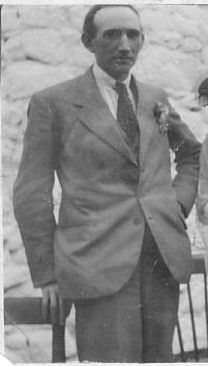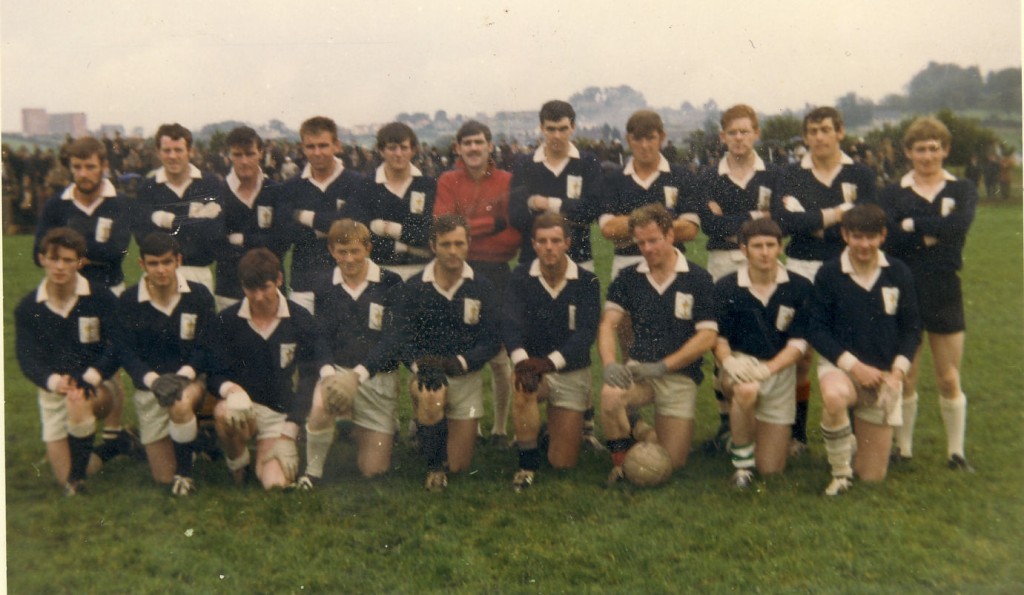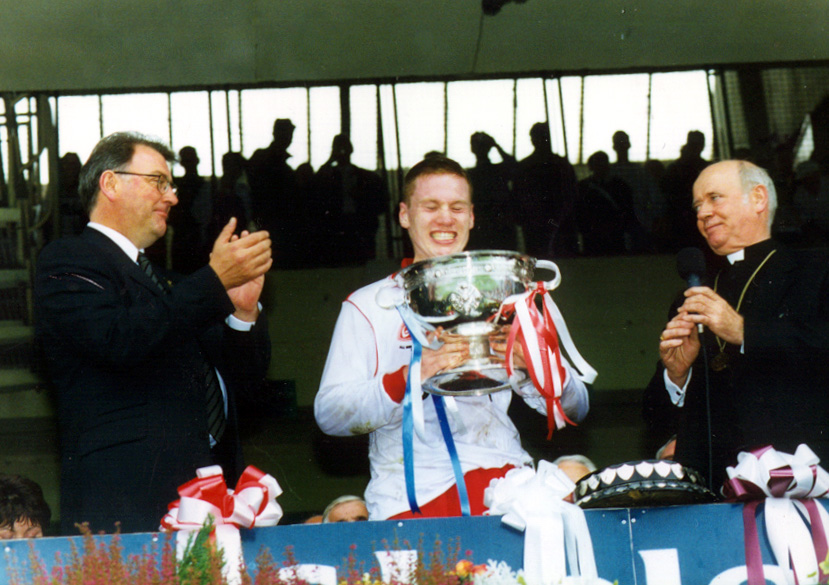Today Cumann Naomh Padraig, An Eaglais is a club which fields ten teams, has 280 members, and boasts facilities to rival that of most clubs in the country. Moreover, it is a symbol and repository of the hopes of the local community, for which it provides diverse services and functions. So how did it come to be? The club in its present format goes back over fifty years, but there are records of games in the area as far back as a century ago.
In the 1900s and 1910s Gaelic football was played sporadically at Reaskmore, and some of the players lived in the Greystone area of Eglish parish. Reports exist of Reaskmore teams travelling to play the Moy in 1907 and 1913. Legilly brothers Henry and Peter Byrne played on the 1907 team. But this team never affiliated to Tyrone County Board, and there are few other records of Gaelic games in Reaskmore. Yet there were other GAA players and supporters in the parish. Another Byrne brother, Paddy, played for Donaghmore in the county football final in 1906, for the Craobh Rua club in Dungannon, and also several times for the TÍr Eoghain senior team. In 1913, a native of Carrowcolmen then living in London, Anthony Lucy, MA, presented the Owen Roe O’Neill Challenge Cup for schools’ Gaelic games in South Tyrone. Paddy and Peter Byrne were then founder members of the Dungannon Clarke’s club in 1917, and their brother Charlie won a senior championship with the Moy in 1920.
In most years there was a sports day of some sort in Eglish, and in 1917 it took the form of an “Aeridheacht and Sports under GAA Rules”. This was a sports-day with athletics events under the GAA’s rules for athletics, but no football or other team ball-games featured. John Shields of Lisnacroy organised the event, and the proceeds were in aid of the Irish language. The large crowd present was reportedly “representative of every shade of political opinion”. For the winners of the various events in 1917, there were luxury prizes among those on offer were a Gladstone bag, a gentleman’s silvermounted umbrella, a fountain pen, an E.P. breakfast cruet, a set of china and a leather handbag.
There was no GAA club per se in the parish at this time, however. Road bowls and soccer were the main sports for working men in the parish for the next twenty years, although Malachy Mallon of Drumay played for TÍr Eoghain in five GAA Ulster senior championships in the late 1920s, as a Clarke’s clubman.
Gaelic games grew stronger in the parish from 1936, when six Brantry men played for the new Benburb GAA club. This club soon folded and the Brantry men then set up their own club. On 11 July 1937 “a large representative meeting” of Brantry Gaels elected the following officers: Chairman, John McAnallen; Secretary, James Burke, Carrycastle; Treasurer, Peter McVeigh. The meeting was reportedly held “in the Gaelic Football Grounds” which suggests that the game was played there for some time previously. The main pitch used by St. Patrick’s G.F.C., Brantry, was a field owned by Bernard Casey, Gort; Kelly’s meadow opposite the Cadian Line limekiln, was also used. At this time the place of Eglish was barely a hamlet, well known for its churches, but with few houses and a small population. Hence for the next two decades, most Gaelic sporting activity in the parish was in the Brantry end, where a greater concentration of nationalists lived. Several founder members of the club were non-natives of the parish, hired to work in big houses of the area.
Coincidentally, the club came into being around the same time as the first Ulsterman assumed the office of President of the GAA,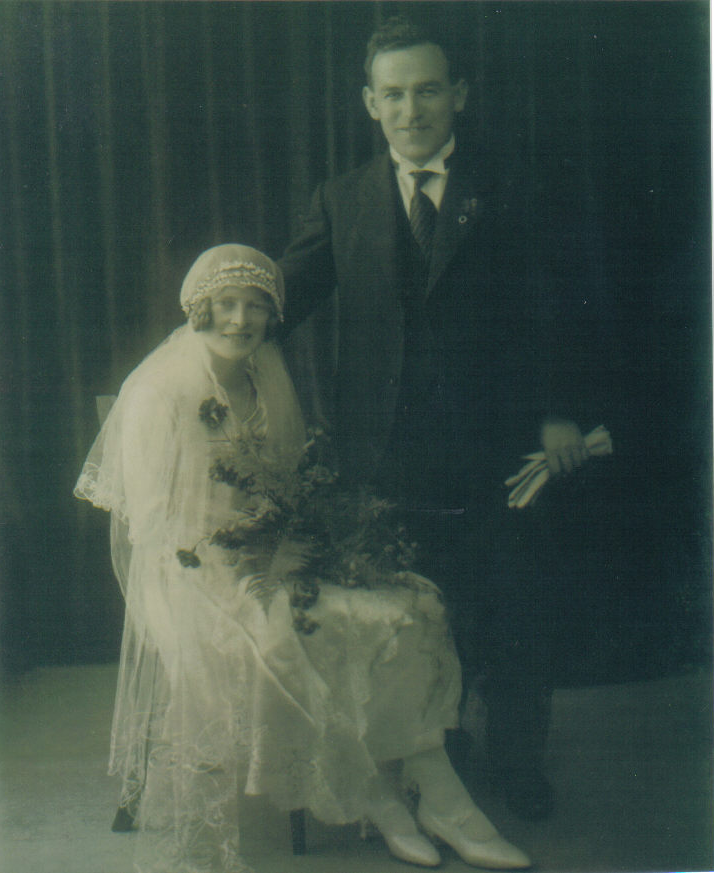 Pádraig Mac Con Mí (1938-42), who had an indirect link to the parish of An Eaglais: his wife, Sarah (née Moore), was a native of Kilnacart who died at the age of 102 in 2006.
Pádraig Mac Con Mí (1938-42), who had an indirect link to the parish of An Eaglais: his wife, Sarah (née Moore), was a native of Kilnacart who died at the age of 102 in 2006.
Within a fortnight the new club held its first big event, a sports-day, which included a seven-a-side football tournament, with teams from the Brantry, Eglish and Benburb taking part. The club then affiliated with the East Tyrone Board in September. On its debut in the East Tyrone Junior Football League in 1938, the Brantry beat Tullyallen at Gaelic Park, Brantry, although more games were lost than won. The club again ran a GAA sports and seven-a-side tournament in 1938, while a similar tournament also featured in Eglish parochial sports, which were run by a parish committee not under the aegis of the GAA.
The Brantry club had some early disciplinary problems. After one match in 1938, three players were suspended for a year each for using threatening language to the referee, and in the next game a Brantry player who was sent off refused to leave the field. The Brantry men soon learned to behave themselves, however, and indeed the club referee, John Hughes of Cadian who attended Croke Park on Bloody Sunday 1920 was much in demand around the county. “Wee John” was in many ways the public face of the club, renowned as he was for walking to and from East Tyrone Board meetings in Coalisland.
With remarkable speed, dedication and resourcefulness the club built its own GAA hall in another field owned by Bernard Casey, opposite the pitch. It was only the second GAA hall in Ulster, and it became a well-known cultural centre for the surrounding area, exceeding even its builders’ imaginations. Among the Brantry GAA Hall’s regular activities were ceílís, Irish dancing and language classes, concerts and plays. Such events attracted patrons from a locus of three counties Tyrone, Armagh and Monaghan. The club’s sphere of influence widened also in playing terms when the new parish priest, Fr. Connolly, initiated a parish league and provided two new footballs for the games. Five teams in all took part over a couple of winters the Brantry, Greystone, Terryglassog, Crubinagh and Eglish.This widening of activity led to the club becoming commonly known as Brantry-Eglish, and to improved results. In 1939 the club reached the East Tyrone Junior final, which it lost to Mountjoy at O Neíll Park, Dungannon, in December, Pat McVeigh became the Brantry-Eglish club’s first county player when he played at wing-back for Tír Eoghain minors in the 1941 Ulster championship.
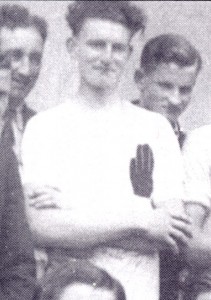 But real success was elusive for the club and the pressures of wartime took their toll. Restrictions on petrol made travel too difficult and playing-fields became unavailable. By late 1941, after four years of activity, the Brantry club had to withdraw from the league, and its players transferred to nearby clubs. Although the Brantry affiliated to the East Tyrone Board in 1943, itdid not rejoin competition for several years. A Reaskmore team played in a Castlecaulfied district league at this time. Among the Reask players was Tony Byrne of Legilly, who, like Fr. Pat McVeigh, Fr. Colm and Patsy Fox of Killybracken, won senior championship medals with Dungannon although Eglish parishioners. Colm Fox brought a first All-Ireland medal to the parish, as a member of the Tír Eoghain panel that won its breakthrough national minor title in 1947. But through the Brantry Hall the GAA spirit was kept alive in the parish. Most clubs then had a team or two but no facilities of their own; the Brantry had its own facilities but no team! Throughout the 1940s the Brantry GAA Hall was a popular venue. Top-billing events included the “big annual harvestime céilidhe”, the annual whist drive and numerous one-act comedies.
But real success was elusive for the club and the pressures of wartime took their toll. Restrictions on petrol made travel too difficult and playing-fields became unavailable. By late 1941, after four years of activity, the Brantry club had to withdraw from the league, and its players transferred to nearby clubs. Although the Brantry affiliated to the East Tyrone Board in 1943, itdid not rejoin competition for several years. A Reaskmore team played in a Castlecaulfied district league at this time. Among the Reask players was Tony Byrne of Legilly, who, like Fr. Pat McVeigh, Fr. Colm and Patsy Fox of Killybracken, won senior championship medals with Dungannon although Eglish parishioners. Colm Fox brought a first All-Ireland medal to the parish, as a member of the Tír Eoghain panel that won its breakthrough national minor title in 1947. But through the Brantry Hall the GAA spirit was kept alive in the parish. Most clubs then had a team or two but no facilities of their own; the Brantry had its own facilities but no team! Throughout the 1940s the Brantry GAA Hall was a popular venue. Top-billing events included the “big annual harvestime céilidhe”, the annual whist drive and numerous one-act comedies.
Other GAA clubs as far away as Dungannon and the Moy also used the hall for social events despite wartime restrictions on travel. Oddly for a GAA club, the Brantry hall hosted agricultural instruction classes organised by the Stormont government. But when Brantry-Eglish got back playing on the field in 1947, they were not entirely obedient to the law they smuggled their green and gold jerseys across the border from Monaghan, on bicycles, to get past customs. After escaping, Brantry-Eglish rejoined the East Tyrone Junior League in 1948, and a parish league was run briefly. Eglish parochial sports were also revived on land owned by Michael Loy (now Barrett’s yard), and Derrylatinee beat Roan by a point in a schools’ football challenge at the 1948 sports.
Brantry-Eglish kept having hard luck on the pitch. When due to host the Rock, the field was waterlogged, and the Brantry officials were unable to inform the Rock officials because the local phone was out of order. On another day against Dungannon juniors, a Clarke’s player deliberately punctured the ball and the game ended: the offender was suspended for a month. Gaelic football in Tír Eoghain was very rough in the 1940s: at least four clubs were suspended for lengthy periods.
Thankfully, the Brantry-Eglish did not get into such trouble with the East Tyrone Board, which actually held one of its meetings in the Brantry Hall in 1949. But the club did have to explain itself when old-time dances were held in its hall; at that time GAA clubs were not allowed to run such dances. The club informed the Board that it did not run English dances; the Brantry GAA Hall, it said, was not the club’s property, but rather that of a hall committee. After this brief interlude, stalwart officials such as old Tommy Donnelly ensured that the hall stayed loyal to its Gaelic name, as it continued to host various Gaelic and other entertainments until the late 1950s. But the Brantry-Eglish team was defunct by 1951, due to emigration and lack of players.
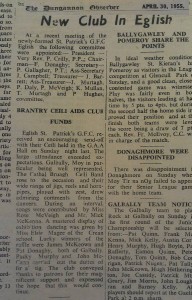 The GAA was resurrected on a much more permanent basis in the parish in 1955, when a club was formed or re-formed at St. Patrick’s, Eglish. In this year some friendly games were played, and the earliest reported club events were a ceílí in the Brantry Hall in April 1955, and another in the parochial hall in August. In an extract from the Dungannon Observer on 30th April 1955 the following officers were elected: President – Very Rev. P. Crilly, P.P.; Chairman – F. Donaghy; Secretary – P. Gallagher, P.T.; Ass-Secretary – J. Campbell; Treasurer – J. Barrett; Ass-Treasurer – J.Murtagh; Committee – P. Daly, P. McVeigh, K. Mullan, T. Murtagh and P. Hughes. The committee collected money for a set of jerseys, and although no one gave more than two shillings, they were able to afford a set of black ganseys with a white hoop. In 1956 the club fielded an adult team and a minor team in the East Tyrone leagues. Although winning only six out of twenty games in this season, Eglish emerged victorious in the Kildress tournament of 1956, by beating the Rock in the final. In 1957 it ran its own eight-team seven-a-side tournament, and soon this evolved into an annual Gaelic Week tournament, in the third week of May.
The GAA was resurrected on a much more permanent basis in the parish in 1955, when a club was formed or re-formed at St. Patrick’s, Eglish. In this year some friendly games were played, and the earliest reported club events were a ceílí in the Brantry Hall in April 1955, and another in the parochial hall in August. In an extract from the Dungannon Observer on 30th April 1955 the following officers were elected: President – Very Rev. P. Crilly, P.P.; Chairman – F. Donaghy; Secretary – P. Gallagher, P.T.; Ass-Secretary – J. Campbell; Treasurer – J. Barrett; Ass-Treasurer – J.Murtagh; Committee – P. Daly, P. McVeigh, K. Mullan, T. Murtagh and P. Hughes. The committee collected money for a set of jerseys, and although no one gave more than two shillings, they were able to afford a set of black ganseys with a white hoop. In 1956 the club fielded an adult team and a minor team in the East Tyrone leagues. Although winning only six out of twenty games in this season, Eglish emerged victorious in the Kildress tournament of 1956, by beating the Rock in the final. In 1957 it ran its own eight-team seven-a-side tournament, and soon this evolved into an annual Gaelic Week tournament, in the third week of May.
Right from the off the Eglish club showed tremendous enterprise despite meagre resources. Eglish village was still a very small place in the 1950s. While initially the club had several players from Benburb, this supply tailed off when the latter village formed its own club again in the late 1950s. So the number of players for Eglish to pick from was limited. Yet the club made rapid progress, winning the East Tyrone Junior Football League in 1960 and 1963, and reaching the county Junior Championship final also in 1963. Although this decider was lost narrowly to Dromore, the Eglish team, coached by Fr. Faul, had now gained promotion to the Intermediate ranks. During this period the team began to record a number of morale-boosting victories in Gaelic weeks around Tyrone. In addition to this growing reputation, the club’s identity was enhanced by the imprinting of an image of the old Eglish Cross on its ganseys this making An Eaglais one of the first clubs in the county to wear a club emblem.
Aptly then it was around this time the club found its permanent home. Joe Barrett had played a key role in the club for the previous decade indeed, for a while he was the only club official who owned a car (a Model Y Ford), and he would spend almost three decades in all as club Treasurer and in 1961, he bought from Barney Connolly a field which was a disused gravel-pit. The parish priest, Fr. Regan, set up a club bank account to buy the field, in what was a very good deal; indeed, it cost less to buy (£490) than it did to level (£500). The ground, which was christened Fr. Connolly Park in memory of a former P.P., was officially opened in May 1964 with a challenge game between Tír Eoghain and Ard Mhacha in which Eglish’s Terry Daly played for Tír Eoghain. The ground was vested in the GAA in 1965, and within a few years a pavilion with dressing-rooms and a referee’s room were built beside it. This period also saw other exciting sporting developments for the village, like the formation of Eglish camogie club, youth club and basketball club, while neighbouring Benburb was also briefly Tyrone’s top hurling club. Eglish as a village was itself expanding, and fortunately for the club Fr. Connolly Park was at the centre of the development, being right beside the new housing estate, Roan Park. Among the main Eglish GAA officials during this decade of great growth were Kieran Mullan, John Mutagh, Patsy Daly, Brendan Muldoon, Patsy McKenna, Sean Donaghy and Henry Daly.
In 1966 Eglish reached the county Intermediate Football Championships final. On the day Eglish lost to Augher, but promotion was achieved anyway by topping the Intermediate League and the opportunity to avenge Augher would soon arise. Already Eglish was gaining the reputation of a “hard but fair” team, physically strong but not unduly forceful. No-one epitomised this more than Mickey Jordan, who starred on Tyrone’s All-Ireland Junior Championship winning side of 1968, with Vincent Daly also on the panel. Such boosts helped keep Eglish on its upward curve, and in 1969 the club gained promotion to the Senior ‘A’ division of the new all-county league and won the Feis Shield competition, while trained to a new level by Master Oliver O’Connor (a Kerry native).
Yet few would have foreseen the glory that the club would achieve in 1970. In its debut in the Tyrone Senior Football Championship final at Ó Neíll Park, Dungannon, on 13 September 1970, Eglish beatAugher by 2-7 to 1-8, with Terence Daly scoring both Eglish goals. The history-making panel was as follows: Paddy Mclntosh, PJ. Fox, Terry Daly, Canice Murtagh, Brian Daly, Mickey Jordan, Henry Daly,Vincent Daly, Kevin Daly, Aidan Daly, Colm Murtagh, Brian Casey, Philip Murtagh, Jim Fay, Terence Daly, Peter Daly, Dominic Daly, Patsy Daly, Eddie Donaghy, Sean Donaghy, Alec Donaghy, Finbar Daly, Phelim Jordan, Kevin Jordan and Liam Hamill. Trainer of the team was the famous ex-Tyrone player John Joe O’Hagan.
After this rapid rise to success, Eglish found itself in the first round of the Ulster Club Championship. The club met Newbridge (Doire) at Ballinascreen, and lost narrowly despite a valiant display. Eglish remained one of the county’s top teams throughout the seventies. The club was so strong that its reserve team reached the Tyrone Junior Football Championship in 1972 and 1973, winning in the latter year by beating Strabane in the final. Also in 1973, and again in 1975, the “Shamrocks” (An Eaglais / Achadh Lu / Cill iseal) combination won county under-21 championship titles. In 1976 An Eaglais complete the set by winning its first All-County Senior Football League. These feats coincided with a great resurgence in Tír Eoghain’s fotunes in inter-county football, so the standard within the county was obviously high at the time. Two local players who starred in the county’s golden run were Mickey Jordan, centre-back on the 1973 Ulster championship-winning senior team, and Kieran Hagan, who won an All-Ireland vocational schools’, provincial minor and under-21 championship medals. The club was not untouched by the northern troubles of the period, however. In 1973, former club player Francie McCaughey was killed by a bomb which was thought to be targeted at him in relation to his work for the new Aghaloo GAA club. From the late 1970s the club devoted a lot of effort to developing its own indoor complex. By the early eighties the Eglish GAA spots complex contained many new facilities, including club spots hall, a stage, an upstairs meeting-room, toilets and a kitchen, and renovated dressing-rooms. In all it cost well in excess of £100,000. To raise funds, members vied to become the ‘Lord Mayor of Eglish’. The club complex was opened at last in 1984, and for many years it was kept meticulously by long-standing caretaker Oliver Murtagh. Over the years the hall held many club functions, including youth-team practices and barbecues, plus a county GAA convention, provincial GAA quizzes, All-Ireland Réadóirí finals, and many Scór evenings. The club only began to take part in Scór in 1979/80 but it was instantly successful. In 1981 and 1982 it won Ulster Scór nanÓg titles in Ceol Uirlise (Instrumental Music). Then in 1984 came the club’s first Ulster Scór Sinsear title, in the Rince Céilí section. But it was in Novelty Act that the club would enjoy its greatest Scór exploits.
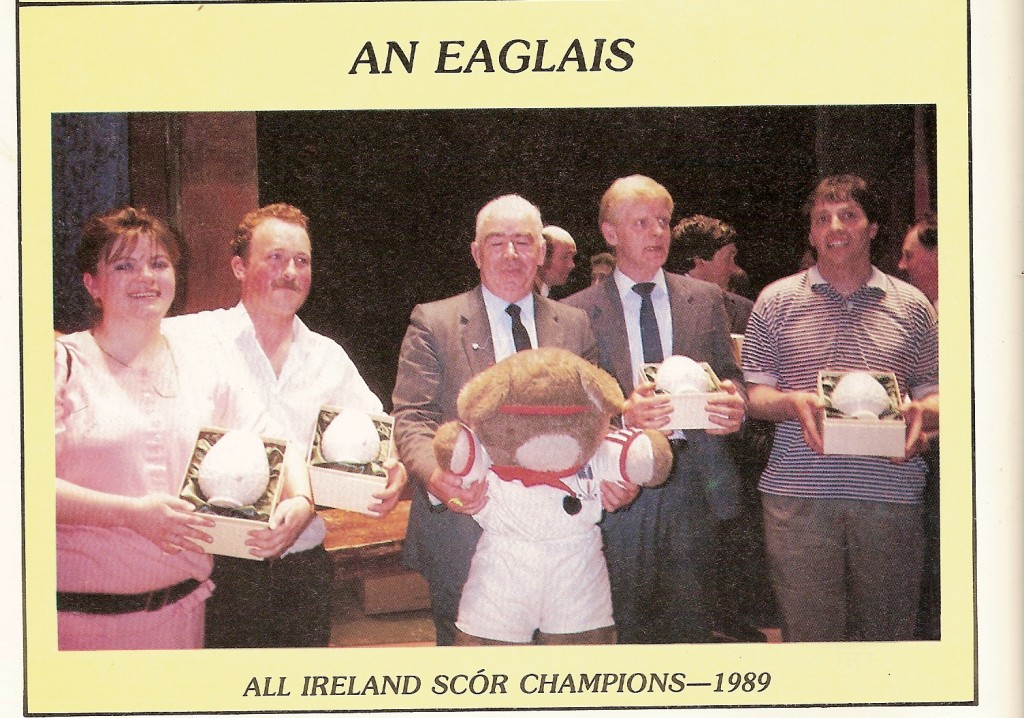 Between 1980 and 1989 Eglish won seven county Scór na nÓg titles in this section, and in 1986 came its first Ulster Novelty Act title in Scór Sinsear. The pinnacle was in 1989, when An Eaglais achieved an unprecedented All-Ireland Novelty Act double of both Scór na nÓg and Scór Sinsear, at the Gaiety Theatre, Dublin. For Jim Daly and Mary McKenna, it was a duel success, as they produced the former act and starred in the latter.
Between 1980 and 1989 Eglish won seven county Scór na nÓg titles in this section, and in 1986 came its first Ulster Novelty Act title in Scór Sinsear. The pinnacle was in 1989, when An Eaglais achieved an unprecedented All-Ireland Novelty Act double of both Scór na nÓg and Scór Sinsear, at the Gaiety Theatre, Dublin. For Jim Daly and Mary McKenna, it was a duel success, as they produced the former act and starred in the latter.
Fr. Connolly Park was not left out of the limelight either. The field hosted many Tyrone senior club championship games over the years, and in 1988 it held its first inter-county senior GAA game a Dr. McKenna Cup game between Tír Eoghain and Aontroim. Another club highlight during this period was the annual ‘Tour of Eglish’ cycle run, organised by Jim Daly. Among the 1980s club officials were Kevin Jordan, Paudge Jordan, Patsy Jordan, Frank McKillion and Canice Mutagh.
At play the club had mixed fortunes in the mid-1980s. The senior won the All-county Jim Devlin Cup tournament in 1983 and 1984; the reserve team won the All-county Division 1 Reserve Championship title in 1986; and the minors, coached by Patsy Jordan, took the County Championships title in 1986 and 1987. But a lot of this good work was undone in a few intemperate moments; after a fight at an Eglish-Moy game in 1986, the county board banned both teams for the rest of the season, and Eglish was duly relegated to intermediate status for the first time in two decades. Emigration and injury then quickly upset the progress of the 1986-87 minor players to senior ranks, and at other youth levels there were few players at all. Some of the 1980s minors later won provincial titles as Tír Eoghain panellists at various levels, but here, as throughout the text, it would be invidious to try to list every county player from Eglish lest we omit someone. We should, however, mention Mattie McGleenan for being the first club member to play in an All-Ireland Senior Football final (in 1995), and for his trademark fisted goals which rescued the county team many times.
In 1992 Eglish won the county Intermediate Football Championship final against Beragh with a goal from Martin Barrett. To this day no-one has worked out how he got the ball into the net. This brought promotion to the senior grade, but relegation followed swiftly after.
The club’s biggest successes in the early 1990s came in Scór. In 1992 and 1993 three further Ulster Scór Sinsear titles were earned two in Novelty Act, and on by Niall Donnelly in Recitation. Liz Daly and Charlie McAuley were driving forces behind other Scór successes in ballad group and set dancing. In 1995 it was the Scór na nÓg Trath na gCeist (quiz) that the club achieved its third national triumph. In all An Eaglais has won 17 Scor na nOg county titles, and 21 Scor Sinsear county titles. Thus it has been the second most successful club in one of the most successful counties in Scor and lies behind only Omagh, the number one Scor club in the county.
On-field, the club returned to form when an exciting group of youth players won the 1996 and 1997 Tyrone M.F.C. titles beating Coalisland in both finals, and also the 1996 county M.F.L. title. In 1997 the club minors reached the Ulster M.F.C. final in Belfast, but lost to arch nemeses Ballinderry. Chief mentors behind these triumphs were Paddy Mclntosh, Ciaran Daly and Conor Daly. Suitably rejuvenated at senior level, the club stormed back to beat Cill Iseal to win the I.F.C. in 1997, under the tutelage of Anthony Daly and Jim Fay. Five of the players on these teams were on the Tír Eoghain team that reached the All-Ireland Minor F.C. final of that year, and Cormac McAnallen captained Tir Eoghain to the All-Ireland M.F.C. title in 1998.
The latter half of the 1990s also saw substantial renovation of club facilities, Fr. Connolly Park was re-surfaced and lengthened to include a practice area; the terraced area for spectators was extended; and the pavilion was expanded to encompass two extra dressing-rooms, a new meeting-room, toilets and several store rooms. Leading club officials since the 1990s have included Jim Daly, Patsy Jones, Sean Donaghy, Martin Jones, Conor Daly, Roisin Donnelly, Cathal Daly, Brian Murtagh and Roisin Jordan. And we should not forget the dedicated band of volunteers who have coached youth teams and sold tickets for the club, with little acclaim, or two referees who have served the club with distinction John McCann and Martin Mohan.
Eglish stated the new millennium with much promise. The club spent eight years in senior competitions from 1998 to 2005, and at one stage or other in this period is beat all of the top teams in the county. Eglish players achieved many individual honours. Cormac McAnallen captained the county to All-Ireland Under-21 F.C. titles in 2000 and 2001, won National Football League medals in 2002 and 2003, played for Ireland for three years in International Rules Football, and manned the full-back beth as the county won its first All-Ireland Senior title in 2003. Both Connall Ó Máirtín and Brendan Donnelly also won Under-21 medals in 2000, and in 2005 the latter became the parish’s second All-Ireland senior medallist. Yet disappointingly the club did not win any major honours during this period and failed to make an impact on the championship.
The death of Cormac McAnallen in March 2004 came as a tremendous blow to the club. While the Gaelic world at large thought of his great loss to Tír Eoghain, it was in his own area and in his own club that his absence was most keenly felt. His death, together with the retirement of some players and other mishaps, led to a drop in team performances, and by 2006 Eglish was back in adult intermediate ranks.
But as the Irish saying goes, “Ó bhás go crioch nach críoch ach athfhás”. The seeds have already been sown for revival in the parish. For the last two years the Campa Chormaic festival of Gaelic games and culture has been hosted in the parish, and with great enthusiasm. Then in 2005 a new club gymnasium was opened in the pavilion, and an ambitious plan was launched to purchase and develop a second club pitch to cater for the ever-increasing demands on the existing facilities. Also in 2005 the club recorded its fourth All-Ireland Scór title, with Corey Mutagh and Joseph Jordan playing industrious road-workers in the Scór na nÓg Nuachleas category. And the triumph of Eglish minors in the 2006 Grade 2 Championship brings to mind previous minor glories for the club ten and twenty years earlier, and builds hope for the future.
